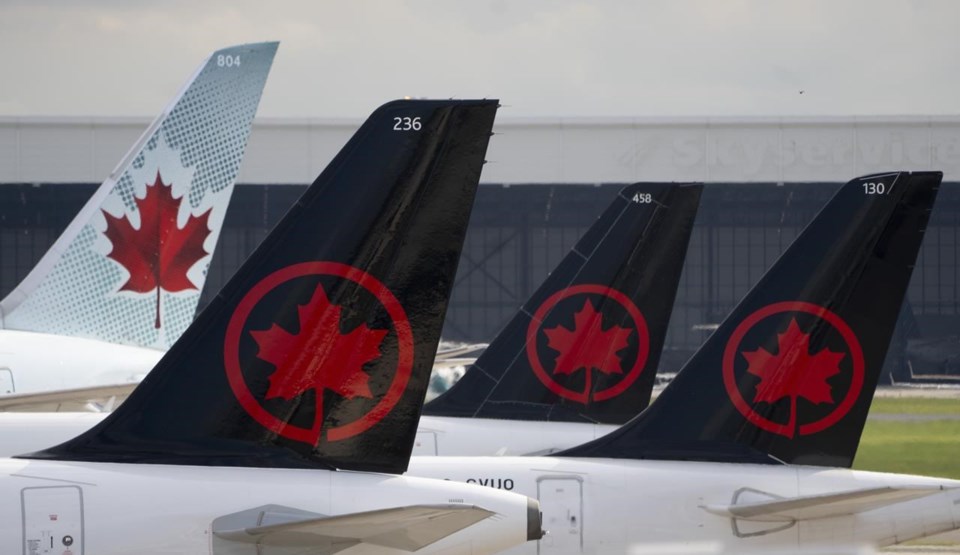MONTREAL — A new report says Air Canada ranked last in on-time performance among the 10 largest airlines in North America, as some carriers north of the border struggle to find their post-pandemic footing despite much better outcomes than the travel turbulence of 2022.
Canada's biggest carrier landed 51 per cent of its flights on time last month, according to figures from aviation data firm Cirium.
WestJet, which placed seventh, saw 62 per cent of its trips make it to the gate on time — defined as within 15 minutes of scheduled arrival.
The two outcomes paled in comparison to top performers Alaska Airlines and Delta Air Lines, which notched 82 per cent and 79 per cent, respectively.
North American airlines' average on-time performance stood at 66 per cent, the worst by far of any of the regions tracked in the report, including Europe, Latin America and the Middle East and Africa.
On top of a shortage of air traffic controllers, Air Canada has pointed to thunderstorms and a network running at full tilt amid high demand, which can mean longer recovery times after a disruption.
Some 140,000 passengers per day flew on Air Canada's 36,000 trips last month, said spokesman Peter Fitzpatrick in an email.
"As with any system, when it is operating at full capacity it may slow processes down and take longer to recover when issues arise. That said, many of the delays were relatively short," he said.
Last month, the International Air Transport Association called out air traffic control organizations in North America, which include Nav Canada, for staffing shortages that "continue to produce unacceptable delays and disruptions."
Nav Canada has acknowledged that some delays at the country's biggest airports over the past two months owe in part to a dearth of air traffic controllers.
As planes wait to land, that time spent circling the runway can tack on hours to flight crews' shifts each week, pushing them closer to their 28-day cap and leaving less leeway for them to plug labour holes by month's end.
Meanwhile, late arrivals mean a smaller window to carry out preventative maintenance between flights overnight, which can result in mechanical issues and more delays down the line, said former Air Canada chief operating officer Duncan Dee.
"If these issues aren't resolved now — or over the next week or so — you're going to see in late July and early August identical challenges as this last weekend,'' Dee said in a July 4 interview.
On Wednesday alone, Air Canada saw 533 delays or cancellations out of roughly 1,250 flights, according to tracking service FlightAware.
The numbers come as a group of advocates submitted recommendations to the Canadian Transportation Agency amid plans by the regulator to overhaul its passenger rights charter.
The joint submission this week — from Air Passenger Rights, the Public Interest Advocacy Centre and Marina Pavlovic, an associate professor at the University of Ottawa’s law faculty — pushes for a clearer, more streamlined version of the regime, called the Air Passenger Protection Regulations.
The proposals seek to shore up passengers' right to assistance, entitlement to compensation for denied boarding, and rules around prompt refunds regardless of the cause of flight disruption.
The submission also aims to more clearly define the "exceptional circumstances" that exempt airlines from compensation after a delay or cancellation, arguing that staff shortages — at airlines or third parties — and maintenance or safety issues should not qualify as exceptional nor relieve carriers of payout obligations.
While photos of snaking lines and posts of passenger frustrations at Toronto's Pearson airport have popped up on social media this summer, the chaos of overflowing terminals and luggage-clogged arrival areas that marked the 2022 travel season have not come to pass, due in part to more prepared players and fully staffed agencies and security contractors.
Fitzpatrick said efforts by Air Canada to improve on-time performance include beefing up staff levels beyond pre-pandemic levels while flying 90 per cent of the seat miles of four years ago.
"Air Canada has continued to trim capacity, primarily in the domestic and transborder (Canada-U.S.) markets," affirmed analyst Savanthi Syth of Raymond James in a research note.
The airline has also spread out flights to ease traffic peaks — particularly in the late afternoon and evening — added 311 last-minute flights to move otherwise stranded passengers in July and partnered with more carriers such as PAL in Eastern Canada, Fitzpatrick said.
July saw 26 days of "significant weather events" in the United States — Air Canada flies to more than 50 American cities — that scrambled operations compared with 19 such days in 2019, before the COVID-19 pandemic struck, he added.
However, the five biggest non-budget U.S. carriers all achieved on-time rates above two-thirds last month, at least 15 percentage points higher than Air Canada.
Compared to the country's other more domestically-oriented airlines, problems across the border or ocean can ripple more strongly through Air Canada's gates, given its international focus. Again though, American carriers are by no means insulated from that headwind either.
This report by The Canadian Press was first published Aug. 10, 2023.
Companies in this story: (TSX:AC)
Christopher Reynolds, The Canadian Press




